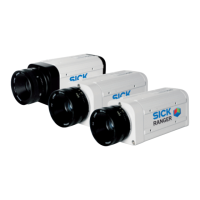Chapter 4 Reference Manual
Ranger E/D
32 ©SICK AG • Advanced Industrial Sensors • www.sick.com • All rights reserved
Ranger Studio
Before generating the 3D surface, the data is filtered by a small
median filter to reduce noise peaks. The 3D zoom window can be of
use even if the data is intensity data.
Profile zoom Blue line. The data is displayed as a profile, where range, intensity or
scatter is displayed as the y-coordinate. For color data, three profiles
are displayed – one profile for red, green and blue respectively.
The contents of the zoom image are updated as the line or rectangle is moved and resized
in the active visualization window:
A rectangle is resized and moved by pressing the left mouse button pointing the cursor
on the frame or in the middle of the rectangle respectively.
A line is moved by pressing the left mouse button while pointing the cursor on the line.
A line cannot be resized – it will always go across the entire image in the visualization
tab.
When viewing the 3D zoom, you can change the perspective and coloring of the 3D sur-
face:
Hold down the left mouse button and move it to change the viewing direction, so that
the object can be viewed from various angles.
Hold down the right mouse button and move it up or down in the image to remap the
coloring of the surface. This can be used to emphasize different parts of the current
data.
When viewing the Profile zoom, you can zoom in on a part of the profile, by pressing the
left mouse button and dragging a rectangle over the area to zoom in on. By clicking with
the right mouse button in the Profile zoom window, the entire profile will be displayed in
the zoom window again.
4.3 Parameter Editor
The Parameter Editor button in Ranger Studio main window opens the Parameter Editor
window, which retrieves the current parameters from the system and allows you to modify
parameters in the camera.
The Parameter Editor consists of three areas: Parameter tree, Parameter list and a Status
bar.
Figure 4.7 – The Parameter editor window.
The parameter tree shows a hierarchical structure of the system configuration. When
selecting an item in the parameter tree all available parameters for that item are shown in
the Parameter list on the right.
Parameter tree
Parameter list
Status ba

